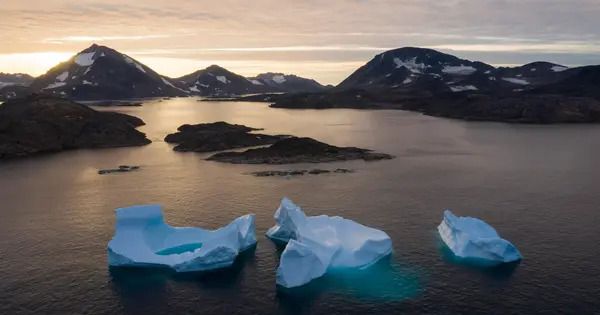Ground-based measuring instruments and aircraft radar in Greenland’s far northeast reveal how much ice is being lost by the 79° N Glacier. According to observations taken by the Alfred Wegener Institute, the glacier’s thickness has dropped by more than 160 meters since 1998. Warm ocean water flows beneath the glacier tongue, melting the ice from below.
High air temperatures allow lakes to grow on the surface, and the water flows through massive channels in the ice into the ocean. One tunnel reached a height of 500 meters, but the ice above was just 190 meters thick, according to a study published in the scientific journal The Cryosphere.
A rustic camp in northeast Greenland served as one of the bases for helicopter deployment of autonomous measuring instruments using contemporary radar technology in a difficult-to-access area of the 79° N Glacier. Measurement flights with the Alfred Wegener Institute’s polar plane, the Helmholtz Centre for Polar and Marine Research (AWI), and satellite data were also used in a scientific study that was just published in the journal The Cryosphere.
This study examines how global warming affects the stability of a floating ice tongue. This is of great importance for the remaining ice shelves in Greenland as well as those in Antarctica, as instability of the ice shelf usually results in an acceleration of the ice flow, which would lead to a greater sea level rise.
We expect that this floating glacier tongue will break apart over the next few years to decades. We have begun to study this process in detail to gain maximum insight into the course of the process. Although there have been several such disintegrations of ice shelves, we have only been able to collect data subsequently.
Dr. Ole Zeising
“Since 2016, we have been using autonomous instruments to carry out radar measurements on the 79° N-Glacier, from which we can determine melt and thinning rates,” says AWI glaciologist Dr Ole Zeising, the first author of the publication. “In addition, we used aircraft radar data from 1998, 2018, and 2021 showing changes in ice thickness. We were able to measure that the 79° N-Glacier has changed significantly in recent decades under the influence of global warming.”
The study examines how a warm ocean inflow and a warming atmosphere affect the floating ice tongue of the 79° N Glacier in northeast Greenland. Only recently did an AWI oceanographic team publish a modeling study on this topic.
According to the unique data set of observations reported here, extraordinarily high melt rates occur over a vast area near the ice sheet transition. Furthermore, extensive channels occur on the underside of the ice from the land side, most likely because water from massive lakes drains through the glacier ice. Both activities have resulted in significant thinning of the glacier in recent decades.

Because of severe melt rates, the ice of the floating glacier tongue has become 32% thinner since 1998, particularly at the grounding line where the ice meets the water. In addition, a 500-meter-high channel has formed on the ice’s underbelly, spreading towards the inland.
The researchers attribute these changes to warm ocean currents in the hollow beneath the floating tongue, as well as surface meltwater discharge caused by global warming. A surprise discovery was that melt rates had dropped since 2018. A cooler ocean influx could be the reason for this. “The fact that this system reacts on such short time scales is astonishing for systems that are inert such as glaciers,” says Prof Dr Angelika Humbert, who is also involved in the study.
“We expect that this floating glacier tongue will break apart over the next few years to decades,” explains the AWI glaciologist. “We have begun to study this process in detail to gain maximum insight into the course of the process. Although there have been several such disintegrations of ice shelves, we have only been able to collect data subsequently. As a scientific community, we are now in a better position by having built up a really good database before the collapse.”
















